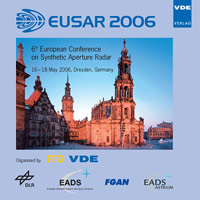Bistatic moving target indication, using across-track and along-track interferometry
Conference: EUSAR 2006 - 6th European Conference on Synthetic Aperture Radar
05/16/2006 - 05/18/2006 at Dresden, Germany
Proceedings: EUSAR 2006
Pages: 4Language: englishTyp: PDF
Personal VDE Members are entitled to a 10% discount on this title
Authors:
Cantalloube, Hubert M. J.; Dubois-Fernandez, Pascale; Giroux, Vincent (ONERA, France)
Krieger, Gerhard (Deutsches Zentrum für Luft- und Raumfahrt, Germany)
Abstract:
Multistatic SAR features both large baseline and single pass acquisition that would allow for accurate moving target indication (MTI) at long range (especially for spaceborne systems). The specific difficulties of this technique are addressed here: There is the clock drift retrieval issue as for any bistatic cross-platform interferometry. Furthermore, unlike monostatic MTI for which the different channel antennae are aligned along the carrier line of flight, the several platforms involved in a multistatic system are not perfectly aligned. The latter has for consequence that the minimum number of channel required for each MTI sub-tasks (detection, localisation/proper velocity determination) increases to 3 and 4 respectively since terrain elevation must be estimated along with clutter and target response. Process is illustrated with data from the 2003 DLR-ONERA bistatic experiment. During this campaign, a few acquisitions with 3 receiving channels (two on the RAMSES system and one on the ESAR system) have been done (with reduced 50 MHz bandwidth to cope with RAMSES system datarate limitation of that time). Even though this data does not correspond to the full complexity of the real case (two channels share the same carrier hence also the same clock) it allows to illustrate the principles of multistatic MTl.


